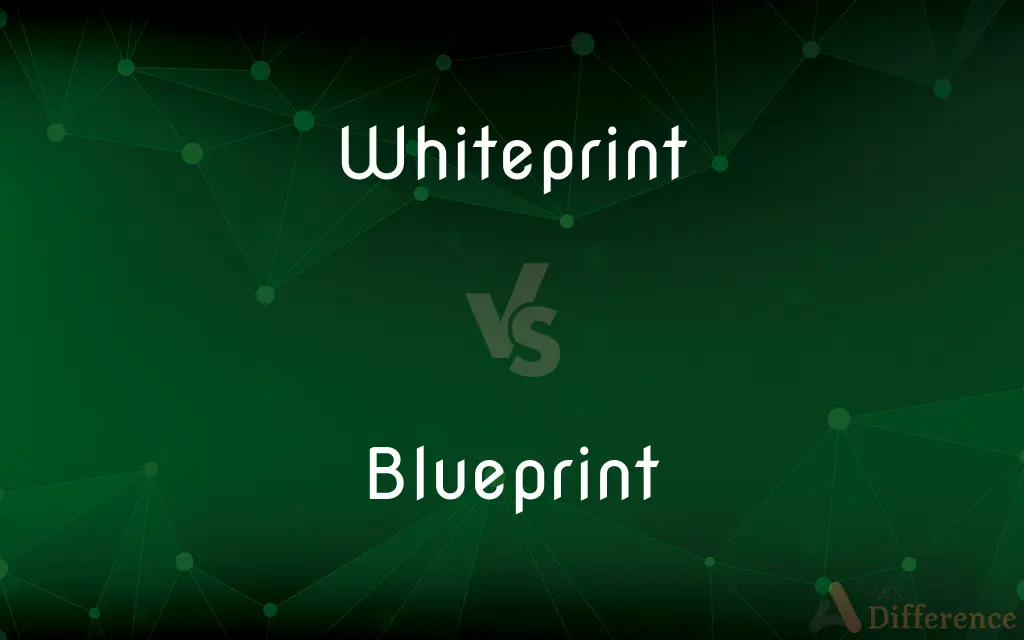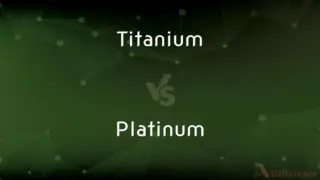Whiteprint vs. Blueprint — What's the Difference?
By Tayyaba Rehman — Updated on October 31, 2023
Whiteprints are reproductions with white lines on blue background, whereas blueprints have blue lines on a white background; both represent architectural plans.

Difference Between Whiteprint and Blueprint
Table of Contents
ADVERTISEMENT
Key Differences
Whiteprints, sometimes known as diazotypes, are technical drawings where white lines appear against a blue background. This method was commonly adopted because it produced copies faster than blueprints. On the other hand, blueprints, a more traditional approach, present designs with blue lines on a white background. The blueprint process uses chemicals and light exposure to imprint an image onto a special paper.
As architectural and engineering designs evolved, the Whiteprint became a preferred choice for many due to its quick turnaround.
Both Whiteprints and blueprints serve the essential function of providing detailed layouts for buildings, machinery, and other structures. However, with advancements in digital printing and technology, the use of both has diminished, replaced by more efficient and versatile methods.
While both were staples in design and construction for many decades, their differences were primarily in the printing process and visual appearance.
Comparison Chart
Appearance
White lines on blue background.
Blue lines on white background.
ADVERTISEMENT
Alternate Name
Diazotype.
Cyanotype.
Printing Process
Uses ammonia and light to develop.
Uses chemicals and light exposure.
Popularity
Became popular due to faster production.
Traditional method used for architectural plans.
Modern Usage
Largely obsolete, replaced by digital methods.
Also largely obsolete, replaced by digital methods.
Compare with Definitions
Whiteprint
A method producing copies faster than blueprints.
Due to the tight deadline, we opted for a whiteprint instead.
Blueprint
Uses chemicals and light for imprinting.
Making a blueprint required careful handling due to the chemicals involved.
Whiteprint
Commonly used for reproducing architectural and engineering drawings.
The contractor examined the whiteprint before starting the construction.
Blueprint
A design plan or technical drawing with blue lines on a white background.
The engineer presented the blueprint for the bridge project.
Whiteprint
A technical drawing with white lines on a blue background.
The architect handed me the whiteprint for the new skyscraper.
Blueprint
Represents a prototype or standard for something.
The successful initiative served as a blueprint for future projects.
Whiteprint
Also known as diazotype.
Many old engineers preferred using whiteprints, or diazotypes, for their drafts.
Blueprint
A blueprint is a reproduction of a technical drawing or engineering drawing using a contact print process on light-sensitive sheets. Introduced by Sir John Herschel in 1842, the process allowed rapid and accurate production of an unlimited number of copies.
Whiteprint
Uses ammonia and light for development.
The distinct smell of ammonia was a giveaway that they were developing a whiteprint.
Blueprint
A contact print of a drawing or other image rendered as white lines on a blue background, especially such a print of an architectural plan or technical drawing. Also called cyanotype.
Whiteprint
Whiteprint describes a document reproduction produced by using the diazo chemical process. It is also known as the blue-line process since the result is blue lines on a white background.
Blueprint
A mechanical drawing produced by any of various similar photographic processes, such as one that creates blue or black lines on a white background.
Whiteprint
A photomechanical copy, usually of a line drawing, in which black or colored lines appear on a white background.
Blueprint
A detailed plan of action.
Whiteprint
A reproduction of a document created by means of the diazo chemical process.
Blueprint
A model or prototype.
Blueprint
To make a blueprint of.
Blueprint
To lay a plan for.
Blueprint
A type of paper-based reproduction process producing white-on-blue images, used primarily for technical and architecture's drawings, now largely replaced by other technologies.
Blueprint
A print produced with this process.
Blueprint
A detailed technical drawing (now often in some electronically storable and transmissible form).
Blueprint
Any detailed plan, whether literal or figurative.
Blueprint
To make a blueprint for.
The architect blueprinted the renovation plan once the client had signed off.
Blueprint
To make a detailed operational plan for.
They blueprinted every aspect of the first phase of the operation.
Blueprint
See under Print.
Blueprint
Something intended as a guide for making something else;
A blueprint for a house
A pattern for a skirt
Blueprint
Photographic print of plans or technical drawings etc.
Blueprint
Make a blueprint of
Blueprint
Historically used method for reproducing documents.
Before digital methods, a blueprint was an architect's go-to for showcasing designs.
Blueprint
Synonymous with detailed plans in various contexts.
The team shared a blueprint for their marketing strategy.
Common Curiosities
What process is used in creating a blueprint?
Blueprints use chemicals and light exposure on special paper to imprint the design.
What's the primary visual difference between a whiteprint and a blueprint?
Whiteprints have white lines on a blue background, while blueprints have blue lines on a white background.
What is another name for whiteprint?
Another name for whiteprint is diazotype.
Are there health concerns associated with either method?
Yes, the chemicals used, especially ammonia in whiteprints, required proper ventilation and care.
Are blueprints and whiteprints still commonly used?
Both have become largely obsolete, replaced by digital printing methods.
Why might someone have chosen whiteprints over blueprints in the past?
Due to their quicker production time, whiteprints were often chosen when speed was essential.
Which method is also known as cyanotype?
Blueprint is also referred to as cyanotype.
Can the term "blueprint" be used metaphorically?
Yes, "blueprint" can be used to mean a detailed plan or guideline in various contexts.
Why did whiteprints become popular?
Whiteprints became popular because they produced copies faster than blueprints.
Which method, whiteprint or blueprint, is older?
The blueprint method is older and more traditional.
Why have these methods become obsolete?
Advancements in digital printing and technology offer more efficient and versatile methods, making the traditional ones obsolete.
In which method might you smell ammonia during production?
You might smell ammonia during the production of a whiteprint.
Can both methods be used for detailed machinery designs?
Yes, both whiteprints and blueprints were used for detailed machinery and architectural designs.
Is the term "whiteprint" used metaphorically like "blueprint"?
While "blueprint" is more commonly used metaphorically for plans, "whiteprint" is typically more literal in its reference.
How are modern architectural plans different from whiteprints and blueprints?
Modern plans are typically digital, offering more flexibility, detail, and easier modifications than traditional methods.
Share Your Discovery

Previous Comparison
Titanium vs. Platinum
Next Comparison
Laid vs. LadeAuthor Spotlight
Written by
Tayyaba RehmanTayyaba Rehman is a distinguished writer, currently serving as a primary contributor to askdifference.com. As a researcher in semantics and etymology, Tayyaba's passion for the complexity of languages and their distinctions has found a perfect home on the platform. Tayyaba delves into the intricacies of language, distinguishing between commonly confused words and phrases, thereby providing clarity for readers worldwide.
















































